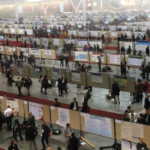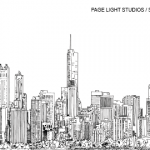Where can you network with more than 16,000 professionals in the field of rheumatology? Where you can hear about promising research and best practices from industry leaders? How can you find out about new treatments and technologies on the horizon? You guessed it—at the 2016 ACR/ARHP Annual Meeting, to be held Nov. 11–16.
As if that’s not enough motivation to travel to Washington, D.C., for this year’s Annual Meeting, ACR staff offer one more reason: “Go for the energy!”
Being around other rheumatologists, rheumatology health professionals and thought leaders from all over the world is an invigorating experience. It will generate a spark that will remind you of why you chose this area of practice, and why each advance, discovery and new policy truly is important and relevant to you. When you return home, you’ll carry the excitement and inspiration of the experience with you.
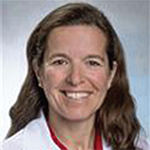
Dr. Gwendolyn Kane-Wanger
For Gwen Kane-Wanger, MD, Division of Rheumatology, Immunology and Allergy, Brigham and Women’s Hospital, Boston, attending the meeting is a top priority. “I like to stay informed for the benefit of my patients,” she says. “I believe that it is very important to understand the different approaches in medical treatments both nationally and internationally.”
Further, Dr. Kane-Wanger adds, “I enjoy the clinical sessions that present outcomes of studies on management strategies. These are critical to our understanding of disease treatment. Last year, I particularly appreciated the many presentations about new biologics in rheumatologic disease management.”
Reflecting on the 2015 meeting, Eleni Tiniakou, MD, rheumatology fellow, Johns Hopkins Medicine, Baltimore, says, “I met pioneers in the field from institutions around the world and learned about their ideas and approaches; I valued the opportunity to get their input regarding my research endeavors.” In addition, she says, “It was great to reconnect with former fellows who now work in different places.”
Must-Attend Sessions
The Annual Meeting will definitely have sessions you won’t want to miss. In this year’s opening lecture, Joseph E. Kvedar, MD, director, Center for Connected Health, Partners HealthCare System, Massachusetts General Hospital in Boston, and author of The Internet of Healthy Things, will speak on the topic of connected health. This session is sure to spark some conversations on how promising technologies can help transform rheumatology.
At the start of the meeting, the Year in Review session will provide an insightful look at the latest and greatest advances in the field of rheumatology from both a clinical and basic science point of view. At the meeting’s conclusion, the Rheumatology Roundup session features classic dynamic exchanges between Arthur Kavanaugh, MD, professor of medicine and director, Center for Innovative Therapy at University of California, San Diego, and John J. Cush, MD, director of clinical rheumatology, Baylor Research Institute, and professor of medicine and rheumatology, Baylor University Medical Center in Dallas, who offer their takes on highlights from the meeting.
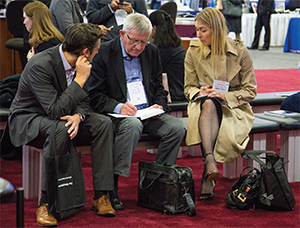
The Exhibit Hall is a good place for attendees to network
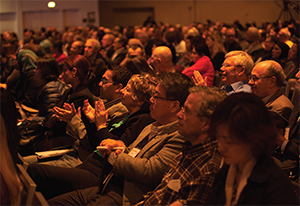
Attendees are always engaged during the Thieves’ Market: Show Me Your Best Cases session.
Attendees looking for sessions that may challenge their current perspectives on disease treatment in a given area may want to attend The Great Debate or Thieves’ Market: Show Me Your Best Cases. This year, Paul Emery, MD, University of Leeds, Chapel Allerton Hospital in the United Kingdom, and Dr. Kavanaugh will debate the topic of To Taper or Not to Taper?—Biologic DMARDs in Low Rheumatoid Arthritis Disease Activity. The top six Thieves’ Market cases will be selected from submissions by rheumatologists from around the world. Both sessions use audience response systems that will allow participants to see how their responses line up with those of their colleagues.
Lastly, if you’re looking for a fun way to challenge your basic knowledge of rheumatology over a wide range of topics, plan to attend the Knowledge Bowl, both the preliminary and final rounds. These sessions pit teams of rheumatology fellows against each other in a Jeopardy! game show-styled trivia competition. The energy in this session is typically palpable.
TechMed Sessions
To stay abreast of technological advances and how you can use technology to improve your practice, consider attending TechMed sessions, which range from topics on social media to data registry. Currently, at least nine sessions are planned and cover a variety of topics, including Smart Office, Smart Home: Adaptations for Rheumatic Disease; Hot Topics in Teaching Techniques: Flipped Classroom, Technology and Reflection; and the Workshop session, Optimizing the Electronic Health Record for Maximizing Productivity in the Rheumatology Clinic.
The Annual Meeting Planning Committee is most excited about piloting the new Flipped Classroom series. These sessions feature a learning format that incorporates both independent study and hands-on training. In short, participants are expected to do homework, such as watching online video lessons or tutorials, working on projects and taking short quizzes, before attending the class. Then, class time is dedicated to discussion and exercises designed to enforce and enhance what pupils learned on their own. The ACR is piloting this educational format for the first time and hopes participants find this type of learning experience to be more personal and valuable.
A Flipped Classroom series titled Digital Scholar Training Series will include two sessions in which rheumatologists can learn from patients’ online conversations and the dos and don’ts of communicating with patients online. This series is for attendees who want to learn how to engage patients in open and honest conversations.

The final round of the ACR Knowledge Bowl
For example, a patient may not tell their doctor about their decreased libido or that they took a sick day because they felt depressed, but if you look on social or patient forums where people are trying to self-diagnose or troubleshoot health issues, they will talk to perfect strangers about their day-to-day issues to seek advice or share insight. Health professionals can learn how to use these forums to ask their patients better questions and gain greater insight into the types of issues that many of them may face. Likewise, those who want to learn how to get involved or facilitate a social or patient forum will find this series helpful.
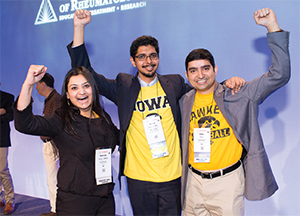
Two-time winners of the ACR Knowledge Bowl, the Iowa Hawkeyes
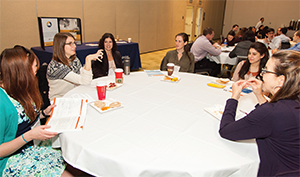
The Student and Resident Experience offers a networking opportunity.
Another Flipped Classroom series will explore how to synthesize big data. Because researchers receiving federal funding are required to report and make public all of their research data, a tremendous amount of information that contains invaluable resources and links to unsolved medical mysteries is just waiting to be discovered and explored. The Big Data Made Practical Workshop session will focus on teaching researchers how to mine big data reservoirs to find hidden gems of information. Many researchers who use these skills theorize that discoveries, links and breakthroughs to challenging diseases such as lupus, cancer and HIV may lay buried in these data. Experts from The Immunology Database and Analysis Portal (ImmPort) will teach the series.
Events of Interest
In addition to the educational sessions, attendees will want to be sure to attend the opening networking event held on Saturday, Nov. 12, from 6:30 to 8 p.m., immediately after the opening session. A big band will provide music and reception food will be served. “This is a fun and informal event that gives our attendees a chance to network with their colleagues from around the world,” says Ron Olejko, senior director of meeting services for the ACR.
Being around other rheumatologists, rheumatology health professionals and thought leaders from all over the world is an invigorating experience.
Of course, you will want to set aside some time to visit the 150,000-square-foot exhibit hall. If 2015 is any indication, you can expect more than 160 exhibitors. “The exhibit hall offers an opportunity to network with exhibitors and learn about new products and services,” says Stacey Chandler, director of expositions for the ACR. Visit the Innovation Theater to listen to presentations by exhibiting companies. At the TechMed Pavilion, you can visit exhibitors that have technology-related products, including apps. Learn about ACR products and services and get answers to your questions at the Discovery Center. The exhibit hall also features morning and afternoon refreshment breaks, as well as a food court and areas to sit and network with colleagues.
“To get the most benefit from the exhibit hall, attendees should view the list of exhibitors prior to their visit—which is available in the meeting app or online,” Ms. Chandler says. “You can search for exhibitors by product and service.”
Maximize Your Time
The meeting is designed in a way that attendees can select which sessions and events to attend with ease. All sessions have been assigned to one of four primary tracks: clinical practice, clinical science, basic science and business/administration. These tracks give attendees a general idea as to whether the information will be of interest based on their area of practice. Sub-tracks, such as fellows-in-training, educators, practice management, pediatrics and TechMed, can help filter a search even further.
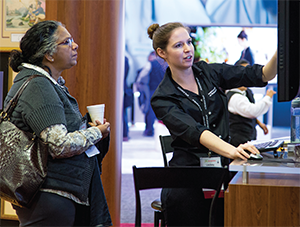
ACR staff member Lindsey Hunter helps an attendee at the ACR Discovery Center during a previous ACR/ARHP Annual Meeting.
In mid-October, attendees can download the meeting app and begin browsing session overviews, learning objectives, talk titles and speakers. You can tag a session as a “favorite,” so later on you can easily pick and choose from your favorites to build an itinerary that provides two options, in case a session becomes full. In most cases, you can use SessionSelect after the meeting to view recordings of sessions that you designated as a favorite but couldn’t attend.
The ACR recommends determining your strategy. If networking and making connections are important, participate in lunchtime events, such as study groups or ARHP networking events. These options feature small- to medium-sized groups (20–200 people) that are designed to foster informal and interpersonal exchanges of ideas and information. Both offer great ways to learn through conversation and discussion.
If you’re interested in a particular topic, disease or skill, browse the Meet the Professor or Workshop offerings. In these sessions, participants get personalized education or training directly from experts in the field. The sessions have 35 or fewer attendees and provide opportunities to network with professionals who share your interests.
Try doing something you have never done. For example, if you are not technology or social media savvy, make it a point to attend at least one of the TechMed session offerings or attend an Innovation Theater session in the exhibit hall. Consider using your lunchtime to attend a study group or ARHP networking event. Don’t be afraid to step out of your comfort zone.
Karen Appold is a medical writer in Lehigh Valley, Pa.
Attendees of the Annual Meeting should have some downtime while in Washington, D.C., to visit the city’s iconic monuments, memorials & museums.
First-Time Attendees: Find Your Place & Navigate the Space
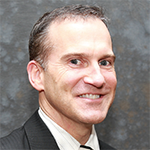
Mr. David Haag
The ACR/ARHP Annual Meeting is the largest rheumatology meeting in the world, with more than 100 countries represented. “Choosing among more than 400 included sessions, among others, while navigating the Washington, D.C., convention center may seem overwhelming,” says David M. Haag, executive director, ARHP. To help you get a handle on choosing the best sessions for your needs and finding your way around, a first-time attendee orientation session, which includes a continental breakfast, will be held on Sunday, Nov. 13, at 7:30 a.m.
At the session, William St.Clair, MD, immediate past president of the ACR, and Kamala Nola, PharmD, MS, immediate past president of the ARHP, will spend an hour walking you through the Annual Meeting—giving you an overview of pre-courses, sessions, tracks, abstracts, third-party events and what to expect in the exhibit hall. Your registration fee entitles you to attend at least 400 sessions on a first-come basis over the four-day meeting. Overflow rooms with video monitors are set up for some sessions. For an additional fee, you can attend intimate Meet the Professor sessions or Workshops with a maximum of 25 or 35 people, where you’ll get to hear about a very specific topic with a subject expert.
“The immediate past presidents will also enlighten you on how to navigate the meeting with the Session Tracker Plus and app and provide an overview of what’s in your registration packet materials, as well as make you aware of helpful resources such as the ACR’s Discovery Center and the technology center,” Mr. Haag says. The session concludes with a question-and-answer period.
If you’re a first-time attendee, you’re not alone. In 2015, more than 2,000 people attended the meeting for the first time. If you’ve attended meetings in the past, you’re still welcome to attend the orientation.
—Karen Appold
Washington, D.C.: Monuments, Museums & Much More
Annual Meeting attendees should have some downtime while in Washington, D.C., and the city is known for its iconic monuments, memorials and museums. In fact, 28.8 million people visited the National Mall this past year, while 27.4 million checked out the Smithsonian. “It’s a one-of-a-kind experience,” says Danielle Davis, director of communications, Destination DC. People come to take advantage of free admission to such places as the U.S. Capitol and Lincoln Memorial, as well as the Smithsonian, which features a collection of 18 museums—including the National Air and Space Museum, as well as galleries and the National Zoological Park.
Although these famous structures are a must-see, D.C. also has much more to offer. If you’re looking to grab a bite to eat near the Walter E. Washington Convention Center, where the ACR/ARHP Annual Meeting will be held, head to the nearby neighborhoods of CityCenterDC, Penn Quarter, Chinatown or Shaw.
Washington, D.C., is consistently named among the top walking cities in America. But to get around faster, use the metro subway system, which has a stop right outside of the convention center, or rent a bicycle at 7th and M streets and dock it at different stations throughout the city.
If you want to see a lot of sites in limited time, Ms. Davis suggests taking the Hop-On Hop-Off sightseeing Big Bus Tour, which allows you to jump on and off at various attractions throughout the city. You may also want to consider a bike or Segway tour—weather permitting.
With the meeting being held from Nov. 11–16, you can be among the first to visit the new National Museum of African American History and Culture, which will open on Sept. 24. The museum is dedicated to the richness and diversity of the African American experience.
In the National Mall area, the National Gallery of Art will reopen its east building on Sept. 30 after a three-year renovation. Explore a new configuration of the permanent collection of modern art as well as a re-opened rooftop sculpture garden.
If you’re a night owl, head to U Street to catch dinner or a jazz show or explore a neighborhood called H Street Northeast, which has a streetcar serving the area. Georgetown is a fun place to whet your palate or go window shopping, Ms. Davis says, or attend a Veterans Day ceremony at Arlington National Cemetery in nearby Arlington, Va.
For a list of 100 free or nearly free things to do in D.C.
—Karen Appold
